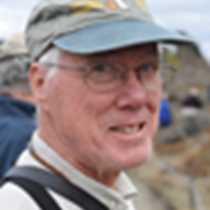Misty Fjords National Monument, Alaska
During the night, the Sea Lion left British Columbia and entered the waters of the great, magnificent, and altogether wonderful state of Alaska. (This is, after all, an Alaskan writing.) We spent our morning in Misty Fjords National Monument. Here, a large granitic pluton, formed at depth in the earth many millions of years ago, has come to the surface. The granite was then carved and shaped by the action of ice over the series of glacial episodes that we call the Ice Ages. The most recent of these ended in Alaska only 14,000 years or so ago – a mere blink of the eye in geological time. It left its signature on the landscape in the steep-walled, U-shaped valleys carved into the granite. Many of these are now flooded by the sea to form fjords -the waterways through which we travel. The Sea Lion took us up one such fjord through mist and morning rain. We stopped by a waterfall in the early morning, our bow nearly entering the stream of water that descended from the remnants of the winter snow pack far above. At our morning destination of Rudyerd Bay, our floating “Jet Dock” and fleet of colorful kayaks came down from the top deck, and we were off to explore by kayak and by Zodiac. Gray mist spilled from the peaks above, snagging on the tips of giant cedars, spruce, and hemlock. Forest spread up impossibly steep slopes, the trees decorated with dangling garlands of epiphytic lichens and masses of mosses. The abundance of such epiphytes is one of the defining characteristics of the Temperate Rain Forest. And Rain Forest it was, as rain continued to fall, dampening the forest but not our enthusiasm. (It is supposed to rain in a Rain Forest!)
Each season in Alaska has its special attraction. In spring, it is the passage of migrant birds, all decked out in their finest breeding plumage. Today the birds were simply spectacular. A flock of white snow geese circled overhead and then settled down to feed on young grasses, replenishing the fuel that will take them to breeding grounds in the tundra far to the north. Hundreds of swallows in a dense flock flew in intricate patterns just above the surface of the water, seeking aquatic insects. The trees and bushes lining the banks were alive with warblers in their breeding finery. For pairs of common mergansers, Barrow’s goldeneyes, and buffleheads the migration has ended and they were proceeding with the next steps of the breeding process, the brightly colored males attentive to every move of their more cryptic mates.
And then we went on, for further adventures await us in our journey through Southeast Alaska.
During the night, the Sea Lion left British Columbia and entered the waters of the great, magnificent, and altogether wonderful state of Alaska. (This is, after all, an Alaskan writing.) We spent our morning in Misty Fjords National Monument. Here, a large granitic pluton, formed at depth in the earth many millions of years ago, has come to the surface. The granite was then carved and shaped by the action of ice over the series of glacial episodes that we call the Ice Ages. The most recent of these ended in Alaska only 14,000 years or so ago – a mere blink of the eye in geological time. It left its signature on the landscape in the steep-walled, U-shaped valleys carved into the granite. Many of these are now flooded by the sea to form fjords -the waterways through which we travel. The Sea Lion took us up one such fjord through mist and morning rain. We stopped by a waterfall in the early morning, our bow nearly entering the stream of water that descended from the remnants of the winter snow pack far above. At our morning destination of Rudyerd Bay, our floating “Jet Dock” and fleet of colorful kayaks came down from the top deck, and we were off to explore by kayak and by Zodiac. Gray mist spilled from the peaks above, snagging on the tips of giant cedars, spruce, and hemlock. Forest spread up impossibly steep slopes, the trees decorated with dangling garlands of epiphytic lichens and masses of mosses. The abundance of such epiphytes is one of the defining characteristics of the Temperate Rain Forest. And Rain Forest it was, as rain continued to fall, dampening the forest but not our enthusiasm. (It is supposed to rain in a Rain Forest!)
Each season in Alaska has its special attraction. In spring, it is the passage of migrant birds, all decked out in their finest breeding plumage. Today the birds were simply spectacular. A flock of white snow geese circled overhead and then settled down to feed on young grasses, replenishing the fuel that will take them to breeding grounds in the tundra far to the north. Hundreds of swallows in a dense flock flew in intricate patterns just above the surface of the water, seeking aquatic insects. The trees and bushes lining the banks were alive with warblers in their breeding finery. For pairs of common mergansers, Barrow’s goldeneyes, and buffleheads the migration has ended and they were proceeding with the next steps of the breeding process, the brightly colored males attentive to every move of their more cryptic mates.
And then we went on, for further adventures await us in our journey through Southeast Alaska.




